The top 100 most valuable global brands 2013
This year’s BrandZ ranking of the top 100 valuable global brands sees Apple maintain its reign at number one and the value of the top brands grow by 7 per cent to $2.6 trillion
| Ranking | Brand | Brand value 2013 ($M) |
|---|---|---|
| 1 | Apple | 185,071 |
| 2 | 113,669 | |
| 3 | IBM | 112,536 |
| 4 | McDonald’s | 90,256 |
| 5 | Coca-Cola | 78,415 |
| 6 | AT&T | 75,507 |
| 7 | Microsoft | 69,814 |
| 8 | Marlboro | 69,383 |
| 9 | Visa | 56,060 |
| 10 | China Mobile | 55,368 |
The world’s biggest brands are worth hundreds of billions of dollars - and this year’s list of the 100 most valuable comes in at an astonishing $2.6 trillion, according to Millward Brown Optimor, which produces the annual BrandZ list.
But what makes a brand worth as much as $185bn, the value of Apple this year? A balance of local and global strength, diversifying into new areas of business, having a strong corporate brand and either being a premium or everyday brand are some of the features which help to make it to the top. The top 10 brands, such as Google ($113.7bn), IBM ($112.5bn), McDonald’s ($90.3bn) and Coca-Cola ($78.4bn) have these qualities in spades, says global BrandZ director Peter Walshe.
“What we see with the most popular or powerful brands is that brand lasts a lot longer, is more robust and doesn’t tend to slip as much, whereas the finances go up and down,” he says, suggesting that brand is more sustainable than financials.
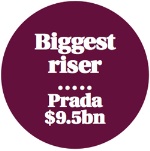
Apple maintains its top slot in the rankings this year because of the strength of its brand, with a value of $185.1bn. However, its rate of growth has slowed by 95 per cent due to a slip in stock price and negative investor sentiment.
“Its brand value only increased by 1 per cent this year but it still holds the record for the most valuable brand. And it leads by a long way. The next brand in the ranking, Google, is worth $113.7bn [reversing a 3 per cent decline last year to a 5 per cent gain] so Apple is $71.4bn ahead - nearly the value of Coca-Cola, which just shows how strong, powerful and meaningful that brand is,” explains Walshe.
If you compare BrandZ’s results since the rankings began in 2006 to the S&P 500 stock index, a portfolio of BrandZ top 100 brands stock prices grew by 52 per cent, proving that companies with stronger brands are able to deliver better value to their shareholders.
“Even though there was a nasty recession and even strong brands were losing share price value at that point, these brands didn’t lose as much and recovered a lot quicker. Brands are worth investing in, they’re worth looking after because they give you a much better return,” says Walshe.
After a flat year in 2012, when the value of the top 100 was up by less than half a per cent, this year sees growth of 7 per cent.
Local vs global strength
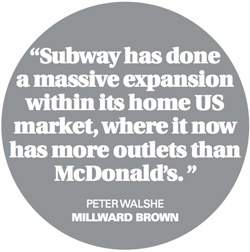
Sandwich brand Subway is the top riser, with the strongest, most sustainable value growth since the rankings began in 2006, growing +5,798 per cent over the years with a value of $16.7bn.
One of the drivers for this is the value offered by the brand, a trait (and possibly the only thing it has in common) it shares with a brand at the luxury end of the market - Hermès - which is at number 4 on the list of top risers worth $19.1bn. It seems it is not about price but value, what you get for your money.
“Subway has done a massive expansion both within its home market, where it’s now got more outlets than McDonald’s, and abroad. It’s done a great job of delivering brand values consistently globally,” says Walshe.
Over the past eight years, all of the top risers to date, except Verizon, have moved into new territories chasing growth and success.
However, this trend varies among categories. In telecoms, local strategies have proved successful for AT&T, China Mobile and Verizon, which have grown their brand values in the last year, while globally-biased Orange and Vodafone saw a decline.
Global presence has driven growth in categories including luxury, fast food and soft drinks.
In banking, global banks are worth $107bn (up 23 per cent in the past year), while regional banks are worth $236bn (up 15 per cent).
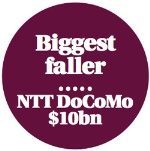
The top half of the BrandZ ranking consists of strong regional and global brands - those that are ‘in limbo’ half way between the two are weaker.
Diversification
Although the technology and telecoms categories are flat in value, they still dominate the top 100 brands. Half of the top 10 brands and 28 out of the top 100 are in this sector and together they account for 40 per cent by value of the top 100.
One of the reasons for the success in telecoms is diversification. The UK’s big newcomer BT is a good example, being worth $9.5bn (see case study, above).
“Because of fibre optics, we are offering new products and services people want and need.
That means strategically we are talking about becoming a better business with a better future,” explains Suzi Williams, group marketing and brand director at BT.
“That brand is making itself relevant in a huge number of spaces,” Walshe comments. “From a consumer point of view it’s being very pleasantly aggressive, getting into sport and television for example. That’s not unique, it’s happening in that space.”
Another example of diversification is Chinese internet service portal Tencent, which has expanded its offering to compete with the likes of Facebook, Twitter and Google. “Tencent is the one brand in this market that’s going into all areas,” explains Walshe. It is worth $27.3bn this year, up $9.3bn from last year.
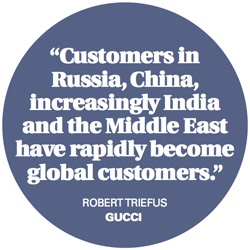
“As a brand it does very well from three main services, including search and messaging. Another way of growing your brand is using it across different areas.”
Squeezed middle
Evidence of a squeezed middle can be seen strongly in the automotive sector, but also across luxury goods (see Q+A), beer and apparel.
Brands such as Volkswagen, BMW and Audi, at the top end of the market, are doing well while those at the other end of the scale, mass market cars such as Hyndai and Kia, are also seeing growth. Meanwhile, the mid-market is seeing its value drop, says Walshe.
“What you’ve got is a pincer movement happening,” says Walshe. “The middle is being squeezed. It’s a very big middle with cars, but if you’re in that sea of sameness, so you’re not different [from the rest], you’ve got a medium and long-term problem.”
Similarly, the luxury category grew overall by 9 per cent in value, putting it 8 per cent ahead of where it was before the recession. In the afterglow of recession, consumers continue to spend on affordable luxuries, but carefully. As they balance their purchases, making room for those luxuries that make them feel better by trading down on other items, middle-of-the-road brands are feeling the effect of this polarisation.
Robert Triefus, chief marketing officer at Gucci, which ranks 68 on the list and is worth $12.7bn, says: “Over the past few years, we have noticed an increasing demand among customers for precious materials, which means the amount the average customer is spending in our store has risen.
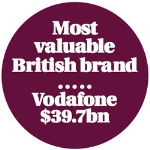
“That plays into the desire of those customers that are interested in luxury to still buy luxury but spend more on one item, rather than purchasing multiple lower-priced items.”
Number 2 luxury brand Hermès benefited from its exclusivity and appeal to the high-end of the luxury market. The increases in profits and sales mean the brand is now valued at $19.1bn and is number 40 in the global ranking. Prada grew its brand value by 63 per cent - the most of any of the brands in the list overall - and is worth $9.5bn, pushing it to number 4 in the luxury rankings.
“Prada has capitalised in growth markets, more than it has before, so it’s done particularly well in Russia, China and Brazil. It always has been a distinct and different brand, so if you expand that premise to a wider market that’s relevant, you’re going to see that growth return,” says Walshe.
The physical aspect of luxury is also a draw for consumers. “That craftsmanship, that feel that it tells a story. That genuine input is something that is valuable, that people want to feel and buy and that’s encapsulated in a brand that’s got that tradition, that history,” says Walshe.
Corporate and brand reputations
Big companies and conglomerates are increasingly tying their corporate identities with their brand identities.
“They are some of the most astute marketers in the world and the reason they’re doing it is that they realise that in this connected world, separation is difficult to achieve, so why not take advantage of it, instead of trying to hide behind it. Why not be proud of what you’ve got and have some kind of cohesion and connection between those things,” says Walshe.
A good example of this in action is Toyota, the world’s most valuable automotive brand, worth $24.5bn. In 2010, it was rocked by a series of safety and quality issues that led to the recall of millions of its cars globally. Toyota recovered from the damage to its corporate reputation in large part because of the strength of its brand.
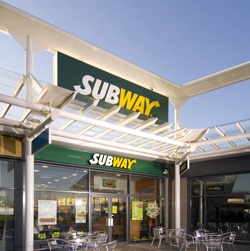
Subway ranks at no. 51, with a brand value of $16.7bn
Procter & Gamble is another brand adopting this tactic, as showcased at the 2012 Olympics. “The London 2012 activation of our Olympics campaign was our largest multi-brand campaign uniting 34 brands under the P&G umbrella. As the Proud Sponsor of Mums, we were able to create an emotional connection between P&G and our brands,” explains Marc Pritchard, P&G’s global marketing and brand building officer. The company has two brands in the top 100 this year - Pampers, which has risen three places to number 32, worth $20.6bn, and Gillette at number 45, worth $17.8bn.
As two well-loved brands in the P&G stable, Gillette and Pampers’ effect on the corporate identity of P&G can only be a good thing.
“This result demonstrates the impact we strive to achieve through our insight-built approach that puts babies at the heart of everything we do,” says Matthew Price, vice president baby care Western Europe.
Pampers is among the top 20 per cent of brands in this ranking that have achieved the highest brand contribution, that is to say, they are among those companies where brand really drives the business.
The brand has an important quality, according to Walshe, of a purpose beyond profit.
“We believe these successes are driven by emotive campaigns such as the Pampers Unicef partnership, which resonates with people because it achieves impact beyond driving profit to the business. This, coupled with our ongoing commitment to category innovation, has contributed to strengthening and retaining Pampers’ position as the number one nappy brand in the world,” says Price.
Meanwhile, Gillette’s global brand leader, John Mang, claims that it shows similar dedication to its consumers.
“We design all our strategies based on both local and consumer needs and insights, and by doing this, we know that we are offering men around the world products and information they will find useful.”
Case study: BT
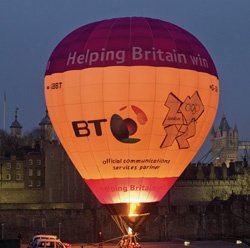
BT has entered the BrandZ rankings for the first time this year, taking the number 94 slot and coming in at number 7 in the top 10 UK ranking. Its brand value is $9.5bn.
“Brands in the telecommunications sector are branching out. You can see that trend happening across the market,” says Peter Walshe, global BrandZ director at Millward Brown. “The redefinition of your category has always been a great way to grow and create uniqueness.”
At the start of the global economic downturn, BT spent £2.5bn on building its superfast fibre network, which has brought broadband within reach of more than half of the UK’s homes and businesses.
“It was incredibly brave to do that during the economic times we’ve had recently,” says Suzi Williams, BT group marketing and brand director. “It means we’ve got new products, new services, we’ve got things people want and need. That’s beginning to really drive success, both for the business and for the brand.”
BT is also expanding into television and customers will be able to buy a complete package of phone, broadband and TV from the brand.
The launch of BT Sport this summer will bring competition to the pay TV market. BT’s three channels - BT Sport 1, BT Sport 2 and ESPN - will provide premium sports content including Premier League first picks, exclusive rugby coverage and women’s tennis.
Q&A

Robert Triefus
Chief marketing officer, Gucci
Brand value: $12.7bn (new entry at 68)
Marketing Week (MW): The luxury category grew overall by 9 per cent in value this year. How would you describe the consumer mindset with regards to luxury?
Robert Triefus (RT): If we think back to the world economic crisis, there was quite a shift away from the notion of disposable luxury to the old values that luxury always used to stand for - quality, craftsmanship and timelessness. For Gucci, which in 2011 was celebrating its 90th anniversary, this was a great moment for us to emphasise those values that have sustained the brand.
The desire was still there to spend on luxury, but perhaps not to buy four bags. Instead, the desire is for one bag that will be long-lasting because the values behind it are long-lasting.
A brand like Gucci was extremely well-placed to take advantage of that changing mindset. In 2009, we started a process of fine-tuning the brand and that process has begun to deliver clear results.
MW: Gucci ranks number 3 in the top 10 luxury brands with a 48 per cent rise in brand value to $12.7bn. What are some of the drivers for this?
RT: The engagement by the brand in the digital space is extremely important, not just because we are able to contribute to our current and potential customers in a richer way, but it is also a differentiator.
At point of sale we’ve invested significantly in digital technology to enhance the customer experience. We’re also communicating with our clients through digital shopping catalogues where you can shop directly from the catalogue online or through the Gucci style app. We have had more than 3 million downloads.
We’re also seeing the benefits of what used to be considered as emerging markets, but are now key markets for luxury, such as Russia, Brazil, increasingly India and the Middle East.
These customers have rapidly become global customers. Chinese customers today are shopping all over the world and are compensating for a softer environment in local markets, particularly in Europe where there are austerity programmes in certain countries.
MW: How do you manage local and global strategies?
RT: We have a macro brand strategy and what we call our ‘micro-clientelling’ strategy that looks at segmentation in a very specific, database-driven way in local markets and develops brand experiences for the local clientele.
The best example of that is a programme called the Gucci Artisan Corner, which allows us to take our artisans from Florence to the retail environment around the world and demonstrate the craftsmanship across our products. It’s a way of underscoring our heritage values in a very direct, person to person way.
Brand valuation methodology
Millward Brown Optimor creates the BrandZ Top 100 global brands list from 14 categories covering five sectors: consumer, food and drink, financial institutions, technology and commodities. It is the only ranking in the world that places a value on the opinion of a brand’s customers, speaking to more than 2 million people in 30 countries.
A brand’s value is calculated by taking the financial value ($) created by a corporation and multiplying it by the brand contribution (%).
The financial value is created by generating profits or earnings. The brand contribution is determined by the proportion of financial value that is generated by the brand’s ability to create loyalty.









